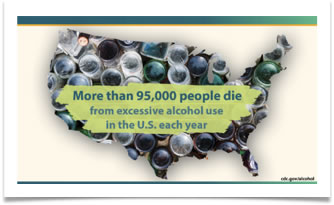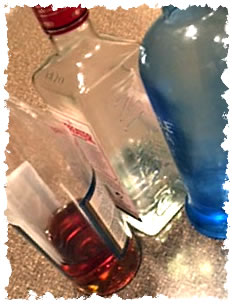Alcohol Use Disorder (AUD)
The Centers for Disease Control and Prevention (CDC) estimates 95,000 deaths in the U.S. occur each year because of excessive alcohol use. The alcohol-related deaths shortened the lives of those who died by 29 years. According to Williams, alcohol use has a 23% addiction rate. It is a leading cause of preventable death in the United States. https://www.cdc.gov/alcohol/features/excessive-alcohol-deaths.html.
 Drinking alcohol has been defined as moderate drinking, binge drinking, and heavy drinking. Moderate drinking is characterized as drinking one alcoholic drink a day for women and two for men. Some research shows moderate alcohol consumption, particularly red wine, may decrease the risk for heart disease. CDC. Fact Sheets- Alcohol Use and Your Health
Drinking alcohol has been defined as moderate drinking, binge drinking, and heavy drinking. Moderate drinking is characterized as drinking one alcoholic drink a day for women and two for men. Some research shows moderate alcohol consumption, particularly red wine, may decrease the risk for heart disease. CDC. Fact Sheets- Alcohol Use and Your Health
https://www.cdc.gov/alcohol/fact-sheets/alcohol-use.htm\
Binge drinking is defined as drinking more than four drinks on a single occasion for women and five drinks for men once in 30 days. Heavy drinking is defined as consuming more than eight drinks a week for women and 15 or more drinks per week for men, as well as five or more episodes of binge drinking in 30 days.
A diagnosis of (AUD) includes:
- Inability to control alcohol intake
- Disregard for problems resulting from drinking
- Involvement in risky situations because of the drinking
- Withdrawal symptoms when stopped
Genetics of Alcohol Use Disorder (AUD)
 Several research studies have found that multiple genes play a role in about 50% of the risk for AUD. Some genes alter the rate of alcohol metabolism leading to flushing, nausea, and rapid heartbeat. These effects lead to an increased avoidance of alcohol. Some genes also enable the effectiveness of some medications like naltrexone to help reduce the desire for alcohol. Still, some individuals without the specific gene do not respond positively to the medication. Much more research is needed and being conducted to examine the effects of genetics on the risk of AUD.
Several research studies have found that multiple genes play a role in about 50% of the risk for AUD. Some genes alter the rate of alcohol metabolism leading to flushing, nausea, and rapid heartbeat. These effects lead to an increased avoidance of alcohol. Some genes also enable the effectiveness of some medications like naltrexone to help reduce the desire for alcohol. Still, some individuals without the specific gene do not respond positively to the medication. Much more research is needed and being conducted to examine the effects of genetics on the risk of AUD.
In a study of dentists, nurses, pharmacists, and physicians, Kenna and Lewis (2004; 2008) found alcohol use was highest amongst dentists, but alcohol use by nurses had a more significant impact. When compared with the general population, healthcare professionals use alcohol less. Alcohol use was strongly associated with cigarette smoking and drug abuse occurring highest in younger and middle-aged health professionals.
Signs and symptoms of AUD amongst colleagues
- Poor work performance
- Coming to work late or calling in sick
- Smell of alcohol
- Sneaking sips of alcohol at work
- Memory losses or blackouts
- History of frequent falls and/or accidents
Instant Feedback:
It is doubtful the pandemic has changed the incidence of substance use amongst nurses.
References
Abramson, A. (2021). Substance use during the pandemic. Monitor on Psychology. 52(2), 22.
Czeisler, M.É., Lane, R.I., Petrosky, E., et al. (2020) Mental Health, Substance Use, and Suicidal Ideation During the COVID-19 pandemic — the United States, June 24–30, 2020. MMWR Morb Mortal Wkly Rep 69,1049–1057. DOI: http://dx.doi.org/10.15585/mmwr.mm6932a1external icon.
Dittman, P. W. (2015). Chemical dependency and nursing students: A complicated process calling for nurse educator involvement. Journal of Addictions Nursing, 26(2), 58–61.
Kenna, G. A., & Wood, M. D. (2004). Alcohol use by healthcare professionals. Drug and Alcohol Dependence, 75(1), 107-116.
Kenna, G. A. & Lewis, D. C. (2008). Risk factors for alcohol and other drug use by healthcare professionals. Subst Abuse Treat Prev Policy. 3, 3. doi: 10.1186/1747-597X-3-3.
Kunyk, D. (2015). Substance use disorders among registered nurses: Prevalence, risks, and perceptions in a disciplinary jurisdiction. Journal of Nursing Management, 23(1), 54–64.
Kunyk, D., Inness, M., Reisdorfer, E., Morris, H., & Chambers, T. (2016). Help-seeking by health professionals for addiction: A mixed studies review. International Journal of Nursing Studies. 60, 200–215.
Mumba, M.N., Baxley, S.M., Snow, D.E. & Cipher, D.J. (2019). A Retrospective Descriptive Study of Nurses With Substance Use Disorders in Texas. J Addict Nurs.30(2), 78-86.
Shields, R.E., Korol, S., Carleton, R.N., McElheran, M., Stelnicki, A.M., Groll, D. et al.(2021). Brief Mental Health Disorder Screening Questionnaires and Use with Public Safety Personnel: A Review. Int J Environ Res Public Health. 18(7),3743.
Zhong, E. H., McCarthy, C., & Alexander, M. (2016). A review of criminal convictions among nursing 2012–2013. Journal of Nursing Regulation, 7(1), 27–33.
©RnCeus.com
 Drinking alcohol has been defined as moderate drinking, binge drinking, and heavy drinking. Moderate drinking is characterized as drinking one alcoholic drink a day for women and two for men. Some research shows moderate alcohol consumption, particularly red wine, may decrease the risk for heart disease. CDC. Fact Sheets- Alcohol Use and Your Health
Drinking alcohol has been defined as moderate drinking, binge drinking, and heavy drinking. Moderate drinking is characterized as drinking one alcoholic drink a day for women and two for men. Some research shows moderate alcohol consumption, particularly red wine, may decrease the risk for heart disease. CDC. Fact Sheets- Alcohol Use and Your Health Several research studies have found that multiple genes play a role in about 50% of the risk for AUD. Some genes alter the rate of alcohol metabolism leading to flushing, nausea, and rapid heartbeat. These effects lead to an increased avoidance of alcohol. Some genes also enable the effectiveness of some medications like naltrexone to help reduce the desire for alcohol. Still, some individuals without the specific gene do not respond positively to the medication. Much more research is needed and being conducted to examine the effects of genetics on the risk of AUD.
Several research studies have found that multiple genes play a role in about 50% of the risk for AUD. Some genes alter the rate of alcohol metabolism leading to flushing, nausea, and rapid heartbeat. These effects lead to an increased avoidance of alcohol. Some genes also enable the effectiveness of some medications like naltrexone to help reduce the desire for alcohol. Still, some individuals without the specific gene do not respond positively to the medication. Much more research is needed and being conducted to examine the effects of genetics on the risk of AUD.